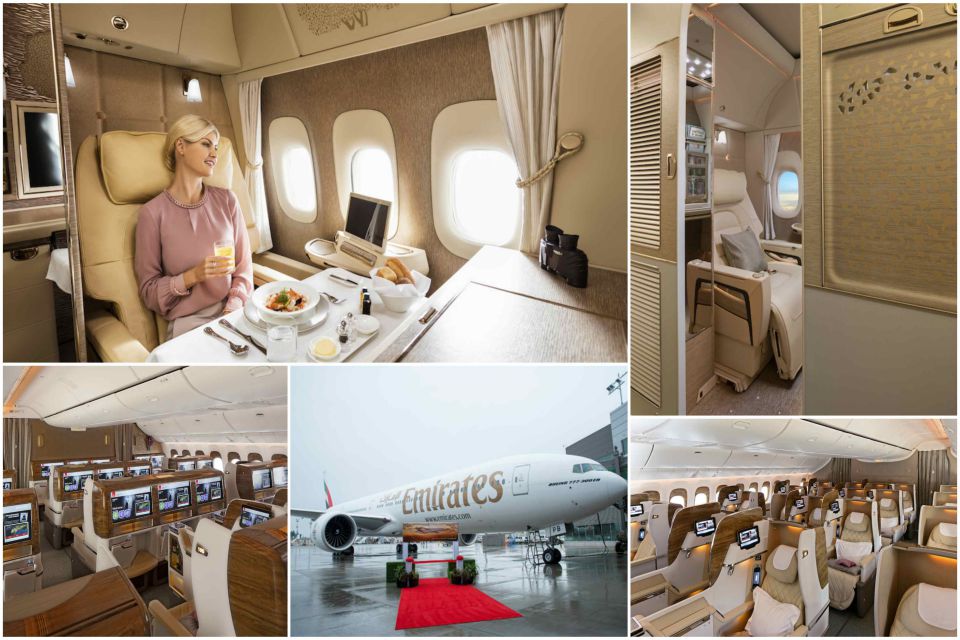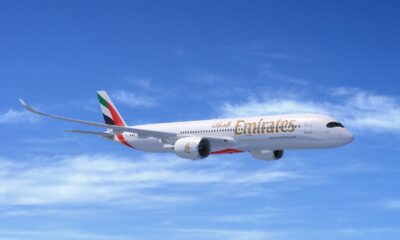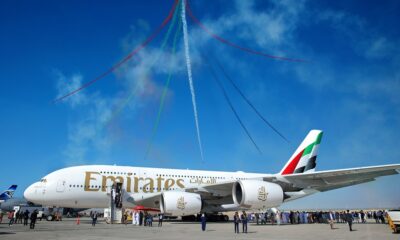Aviation
Emirates unveils brand new cabins for its Boeing 777 fleet

Dubai, UAE, 12 Nov 2017 – Emirates has unveiled completely refreshed interiors for its Boeing 777 aircraft, including its highly anticipated new First Class private suites.
With floor to ceiling sliding doors and sleek design features inspired by the Mercedes-Benz S-Class, Emirates’ new suites takes luxury and privacy to the next level. Offering up to 40 square feet of personal space each, these spacious, fully-enclosed private suites are laid out in a 1-1-1 configuration.
From First Class through to the Business and Economy Class cabins, all along the walkways, in the washrooms and galleys, the latest Emirates 777 aircraft boasts a multi-million dollar upgrade that includes newly-designed seats and upgraded inflight entertainment systems in all cabins.
Emirates’ latest First Class product gives a nod to the design philosophy of the Mercedes-Benz S- Class, bringing together two global brands renowned for innovation, luxury, and comfort. The collaboration inspired several design details in the private suite including the soft leather seating, high-tech control panels, and mood lighting.
Extending that trademark inflight experience to exclusive on-ground services, Emirates and Mercedes-Benz have extended their partnership to provide a fleet of the S-Class cars as part of its complimentary Chauffeur-drive service. Emirates First Class passengers arriving or departing in the UAE will enjoy a seamless journey from aircraft to home, and vice versa, in a Mercedes-Benz S-Class car.
The latest Emirates 777 aircraft with these new features will enter commercial service on 1 December, making its debut on flights to Geneva and Brussels.
Changing the game in First Class – key product features
The new Emirates 777 First Class cabin interior uses a whole new colour palette of soft greys, cream and champagne, conveying a contemporary, open and airy feel, with quiet and timeless luxury.
Created in collaboration with Boeing, Rockwell Collins interior systems, Panasonic, Jacques Pierre Jean Design studio and Seattle-based design firm Teague, each fully enclosed private suite has a floor to ceiling sliding door, and combines smart technologies and intelligent design to deliver function, as well as luxury and comfort.

The soft leather seat reclines into a fully flat bed and can be placed in a “zero-gravity” position inspired by NASA technology, giving a feeling of relaxation and weightlessness. The roomy suites also have ample space for passengers to change in the privacy of their suites even after the bed has been made.

To ensure all First Class customers have a view, Emirates is introducing the industry’s first virtual windows for suites located in the middle aisle. These virtual windows project the view from outside the aircraft using real time camera technology. In the other suites, binoculars are available for customers who want to explore the sky outside their windows.
Passengers can easily communicate with the cabin crew, or request for room service using the video call function. The suites also come with a service window where customers can be served drinks and canapes undisturbed.
Emirates has retained and updated the most popular features of its private suites such as: the personal mini bar for drinks and snacks within each suite; and wireless controls to adjust seating positions, as well as to navigate Emirates’ award-winning inflight entertainment system, ice.
Customers can view over 2,500 channels of on-demand entertainment on a 32-inch Full HD LCD TV screen, or project content from their own devices. The viewing experience is now enhanced with brand new Bowers & Wilkins Active Noise Cancelling E1 headphones created exclusively for Emirates. These headphones were designed by award-winning audio brand Bowers & Wilkins to ensure the sound was optimised for the First Class cabin environment.
Each suite is fitted with an inspiration kit which features a luxury Byredo skincare collection found only on Emirates, Hydra Active moisturising pyjamas, and Bulgari amenity kits.

There is ample storage within the suite including a cleverly designed overhead compartment, and a full length cupboard for hanging clothes.
As with any Emirates flight today, First Class customers can enjoy dine on demand service, with a selection of the finest cuisine prepared by gourmet chefs, accompanied by some of the most exclusive wines, champagnes and spirits in the world. They will be well looked after by Emirates’ international cabin crew representing over 135 nationalities.

Upgrades across all cabin classes
The entire Emirates 777 aircraft sports a refreshed interior with a light and modern colour scheme, classy textured panels, as well as new lighting and design accents.
An artistic motif representing the Ghaf (prosopis cineraria) tree, is used as a design highlight throughout the aircraft. An indigenous evergreen plant, the Ghaf is a considered the national tree of the United Arab Emirates, and has deep cultural and ecological significance.

The design and shape of Emirates’ Business Class seat onboard the new 777 was also inspired by the interior of a modern sports car, with a diamond stitch pattern on the full leather cover, ergonomically designed headrest, and a sleek overall look and feel.

The seat has a pitch of 72 inches and moves into a fully-flat sleeping position. It also has touchscreen controls for the seat and inflight entertainment system, several personal lighting options, privacy panels between seats, a shoe stowage area, footrest, and a personal mini-bar.

The Economy Class cabin now features a colour palette of soft greys and blues. The ergonomically designed seats come with full leather headrests that have flexible side panels and can also be adjusted vertically for optimum support.

All cabin classes will be equipped with a new generation of Emirates’ award-winning ice inflight entertainment system offering improved and superior image quality. Each in-seat screen will feature ultra-wide viewing angles, a capacitive touch screen, LED backlight and full HD display.

Emirates and the Boeing 777
Emirates is the largest operator of the Boeing 777 aircraft, one of the most popular and advanced wide-bodied aircraft in commercial operation today. The airline has 165 Boeing 777s in its fleet, and a further 164 on firm order, including 150 of the next generation Boeing 777x aircraft. Today, Emirates operates the Boeing 777 to over 140 cities on six continents from its hub in Dubai.

Aviation
South Korea Introduces Cutting-Edge MRO Center for F-35 and IAI

South Korea is set to make waves in the aerospace industry with the establishment of a cutting-edge Maintenance, Repair, and Overhaul (MRO) hub for F-35 fighter jets and IAI (Israel Aerospace Industries) aircraft.
Central to this initiative is the specialization in converting Boeing 777-ERSF, colloquially known as the “Big Twin,” from passenger to freighter configurations. Under the terms of the agreement, IAI will spearhead the conversion of six B777-300ER and B777-200LR aircraft annually, commencing in 2024. This strategic move is in response to the anticipated surge in demand for wide-body freighter aircraft capable of long-haul flights.
Furthermore, South Korea’s forward-looking vision extends beyond aircraft conversion, with plans to establish a Lockheed Martin F-35 maintenance, repair, and overhaul depot at Cheongju Air Base by 2027. This strategic move not only enhances the operational readiness of South Korea’s air force but also positions the nation as a regional hub for F-35 maintenance expertise.
In preparation for this expansion, thirty Republic of Korea Air Force (ROKAF) engineers and technicians are slated to undergo intensive maintenance training in the United States in 2025, a testament to South Korea’s commitment to fostering local expertise and talent.
IAI’s visionary approach to certification and collaboration underscores the potential for transformative change. With plans for the 777-300ERSF certification process set to unfold in Israel, followed by the rigorous scrutiny of regulatory agencies such as the US Federal Aviation Administration (FAA), the stage is set for the ‘Big Twin’ to soar to new heights of success.
In partnership with esteemed entities like STK and Incheon International Airport Corporation, this collaboration promises to unleash a wave of benefits, amplifying the resilience and competitiveness of the Korean aviation sector while catalyzing job creation and economic prosperity.
Aviation
Lockheed Martin Expresses Interest in Joining AMCA Project

Lockheed Martin, a leading global aerospace and defense company, is demonstrating its dedication to strengthening collaborations with India’s research, industry, and academic sectors. With its rich experience in the aerospace industry and renowned for building some of the world’s most advanced jets, Lockheed Martin is now exploring opportunities to contribute to India’s aerospace sector, potentially providing a significant boost to aerospace technology in the country.
Randy Howard, Vice President of Global Pursuits at Lockheed Martin Aeronautics, recently underscored their interest in exploring “advanced transfer of technology opportunities” with Indian partners, signaling a proactive approach towards fostering technological exchange and advancement in the aerospace domain.
India has been at the forefront of fighter jet development since the 1970s, having produced its own cost-effective fighter jets and combat helicopters, while continually upgrading to maintain competitiveness on a global scale.
Lockheed Martin stands as a dominant force in the aircraft industry, renowned for developing cutting-edge planes like the F35 and F22, some of the most advanced fighter jets globally. They’ve also contributed to projects like the South Korean KF21 aircraft for defense purposes through collaborations.
Now, Lockheed Martin has set its sights on India’s defense sector manufacturing processes, expressing interest in partnering with India on its most anticipated project, the Advanced Medium Combat Aircraft (AMCA), likely to be a 5th generation fighter jet for the Indian military.
Their proposed collaboration could involve a spectrum of advanced technologies, including the Auto Ground Collision Avoidance System (Auto GCAS), a life-saving technology that intervenes to prevent ground collisions, thus significantly enhancing flight safety for Indian pilots.
Lockheed Martin is extending its expertise to design and develop an indigenous cockpit for the F-21 fighter jets, which India is procuring. This collaboration with Tata also includes the development of fighter jet wings. Established in 2023, this partnership adopts a “Ground Floor Design” strategy aimed at equipping India with an in-depth comprehension of 5th-generation cockpit technology and Man-Machine Interface (MMI) systems.
As India’s Fighter jet program advances with finalized aircraft frame and engine prototypes, Lockheed Martin has expressed interest in joining the project. They see a groundbreaking opportunity in cooperative 5th Generation Fighter Development, potentially expediting the AMCA program’s progress through technology and expertise sharing.
Furthermore, Lockheed Martin is keen on collaborating on large-wing, jet-powered UAV platforms, which could enhance India’s unmanned aerial capabilities.
While discussions are ongoing, and specific collaboration details await finalization, this initiative represents a potentially transformative stride in India’s aerospace self-reliance journey and Lockheed Martin’s strategic engagement with the Indian market.
Aviation
Can Airline Seat Cushions Be Used As Life Jackets?

In the event of an aircraft ditching into water, there’s a common question: Can aircraft seats serve as an alternative to life jackets for flotation? The answer lies in understanding their respective functions.
While seat cushions can provide some buoyancy in water, they are not intended nor certified to function as life jackets. Their primary purpose is to offer cushioning for passengers during flight. On the other hand, life jackets are meticulously engineered to keep individuals afloat in water, equipped with buoyancy materials, secure straps, and reflective elements for visibility. They offer numerous advantages over mere cushions.
While a seat cushion might offer temporary assistance in staying afloat, it’s not a dependable substitute for a proper life jacket during an emergency. It’s crucial to utilize approved safety equipment when near bodies of water. A life jacket, designed to keep a person buoyant for extended periods, offers the rigidity needed for prolonged flotation and allows for easy movement of the arms to navigate effectively.
What fabric is used in aircraft seats?
Seats are meticulously designed to fulfill multiple purposes, ensuring passenger comfort, safety, and protection from unforeseen circumstances like fires and accidents. A typical design incorporates an aluminum frame with blocks of polyurethane foam affixed to it. Additionally, a layer of fire-resistant fabric, such as Kevlar or Nomex, is often applied over this framework, topped with a layer of cloth or leather.
Leather seats, while luxurious, are more expensive compared to traditional cloth seats. The majority of fabrics used in seat upholstery contain at least 90% wool fiber, with the remainder typically consisting of polyamide (nylon). Wool stands out as the primary fiber chosen for commercial airline seating fabric due to its desirable properties and suitability for such applications.
What is the lightest economy seat?
In recent times, airlines have been downsizing seat dimensions to accommodate more passengers, resulting in reduced cushion length and leg space. This contrasts with earlier times when airlines offered more generously cushioned seats and ample amenities.
According to Recaro Seats Company, their SL3710 model represents the lightest economy class seat available, weighing in at a mere 8 kg (17.6 lb.), setting a new standard in aircraft seating.
For individuals weighing more than 350 pounds, fitting into a standard economy-class seat can be a challenge due to the narrower dimensions. Economy seats, also referred to as “coach,” “standard,” or “main cabin” seats, typically range from about 40 to 48 centimeters in width, further emphasizing the need for more accommodating seating options.



























